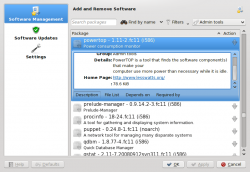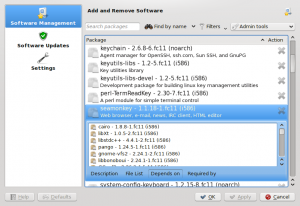KPackageKit
Template:I18n/Language Navigation Bar
 |
A graphical tool to manage your packages |
Features
- Manages installation and un-installation of packages
- Manages package updates
- Can be searched by package-name, description, or included file name
- Supports filtering on
- Installed or available
- Free or non-free
- End-user or development
- Graphical or text-only
- Can be viewed in package groups
Installing packages
If you know the name of the package, you can simply type that into the search bar - the default is to find by name.
Suppose, though, you need suggestions for suitable packages. This time you would choose to Find by Description. For instance, entering flaac into the search term then selecting Find by Description you would be presented with all packages that are related to the use of flaac files. Installed packages show a grey X (which will be used if you need to remove something) and available packages have a grey down-arrow.
So - you have a list of suitable files. Click on one of them and a panel opens giving you a description of the file. There are three other options to display - a list of files included in the package, a list of dependencies (which will be automatically handled if you choose to install) and a list of applications that depend upon the package you choose.

Having found the application that is best for you, click on the down-arrow and you will see both the package icon and the action icon become active. Click OK, and your package will be installed.
